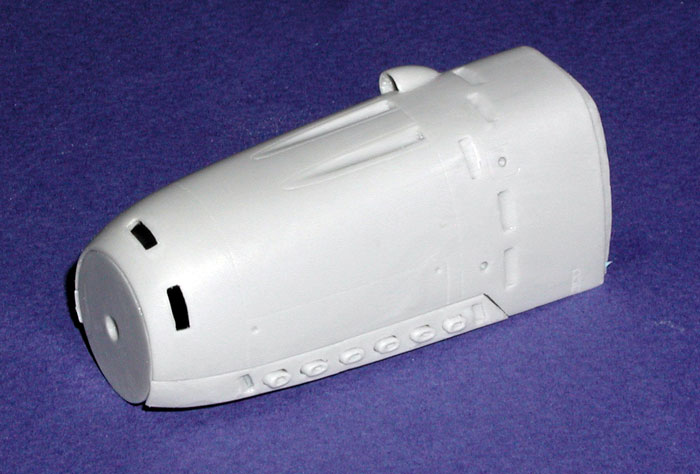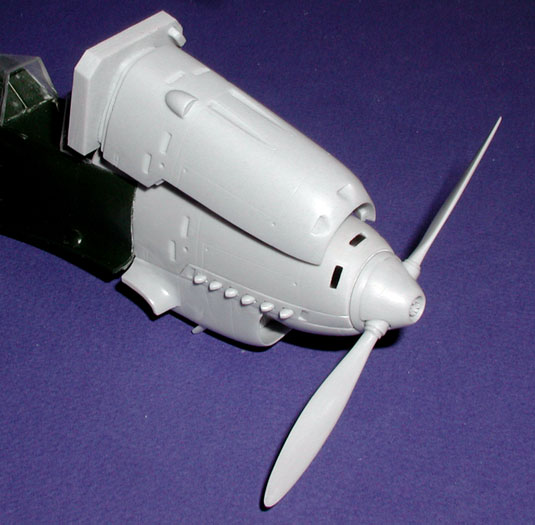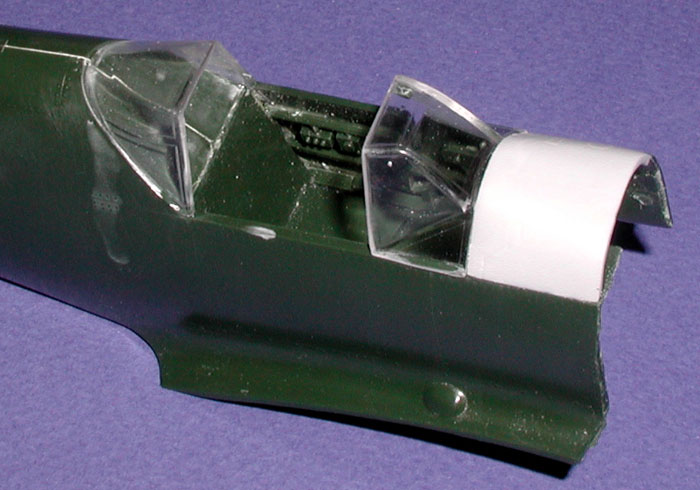|

Cutting
Edge's 1/32 scale Bf 109 Early Conversions
are available online from Meteor
Productions
Dave Klaus from Cutting Edge Modelworks has provided
the following information about their new 1/32 scale early Bf
109 conversions, which are shipping now:
The three conversion sets for the
early 109s are now available from Cutting Edge to fit the 1/32
Hasegawa Bf 109E kit.
There has been some discussion
about why these sets are fitted to the Hasegawa kit and not the
reputedly “more accurate” Matchbox kit. There are several specific
reasons.
FIRST, however, we’ve test fitted our early cowling to the Matchbox
kit, and amazement of amazements, it actually fits reasonably well
(although as I said, it is specifically designed for the Hasegawa
kit and if you use it on the Matchbox kit you’re on your own!).
Okay, so why Hasegawa? First, it’s still in production, and the
Matchbox kit has been gone for years and years. The fit is pretty
awful, but for a kit that’s about 35 years old (that’s 173 in
modelers’ years), we can live with it.
Second, the Hasegawa kit has raised panel lines and the Matchbox kit
has leftover trenches from WW I France. Would you prefer to sand off
gently raised panel lines and scribe new ones, or fill trenches and
scribe right over the top of the area you just filled? Most of you
told us you’d rather start with Hasegawa kit.
Third, those who claim the Matchbox kit is “more accurate” may
possibly be technically correct in some abstract way, but those
who’ve actually built it will tell you the fit is just as bad on the
Matchbox kit as on the Hasegawa kit, and crucial parts like the
canopy and flaps must be discarded and new parts made because the
kit parts are simply unusable.
Finally, when we asked around several years ago when this project
first started, literally everybody we asked said they prefer
Hasegawa. So, Hasegawa it is.
Because of the continuing
confusion about early 109 nomenclature, it is worthwhile repeating
here what we have already described to Meteor’s clients several
times. In short, we're using the nomenclature system provided by
Lynn Ritger in his book on the early Bf 109s. More about this below.
Bf 109s in the Spanish Civil War - are YOU confused?
Conventional wisdom has it that
during the Spanish Civil War, Germany sent Bf 109B-1s, Bf 109B-2s,
Bf 109C-1s, Bf 109D-1s, and finally Bf 109Es as part of the Condor
Legion in support of Franco's Nationalist forces.
Enter Lynn Ritger. You may know
Lynn as the brains behind the 109 Lair website and as a Bf 109
expert. He's also a fantastic modeler (even if his subjects might be
a little "repetitive" - he has built, I think, more Bf 109 models
than Germany produced actual aircraft).
Lynn's first book, The
Messerschmitt Bf 109, A Comprehensive Guide For the Modeller, Part
1: Prototype to "E" Variants, is a must-read if you're a 109
aficionado. In fact, this book is crucial if you want to understand
what we've just released in 1/32 scale.
(What follows next comes from my
reading of Lynn's monograph; if there are errors, they are mine and
not Lynn's.)
Lynn based his book on a huge
amount of personal research and amalgamation of the latest research
by such luminaries as Ken Merrick, Willy Radinger, Michael Ullmann,
and Walter Schick, and the results form a major contribution to the
universe's knowledge base about the 109. We do not sell this book,
but obviously I strongly recommend you find a copy for your library.
"Here's Why This Is Important!"
Fasten your seatbelt...it's gonna
be a bumpy ride...
Lynn has discovered that the first
109s in Spain (other than the Bf 109 V3, V4, and possibly the V6)
which were there for a preliminary combat test) were Bf 109As! This
is huge, and will come as a big surprise to most of you. He lays out
in his book why this was so, and his evidence is compelling.
The second increment of 109s to
reach Spain was Bf 109B-1s--and hold on to your hat--there were not
only NO Bf 109B-2s in Spain, there was no such thing as a Bf 109B-2!
This completely flies in the face of nearly all previously published
material, but Lynn lays out the details in a most compelling way.
Eventually a few Bf 109C-1s and a bunch of externally identical Bf
109D-1s also reached the Condor Legion, but this information is
already widely known.
Okay, why do you need to know
this? Because we're now shipping our 1/32 Bf 109A, Bf 109B-1, and Bf
109C/D conversion sets for the Hasegawa Bf 109E kit, and we're using
the nomenclature Lynn lays out in his book. This is certain to
confuse some, because they will not be expecting a Spanish Civil War
aircraft called the "Bf 109A," and they will wonder why none of our
sets are marked "Bf 109B-2."
Lynn and some other guys have been posting interesting facts about
these aircraft on my blog
http://blog.meteorprod.com, so jump on over to see what they
have to say!
The Cutting Edge Sets
These are complicated sets
intended for serious, experienced modelers. The resin bits
themselves are not particularly difficult, but the Hasegawa kit fit
is so bad there are numerous ways you can assemble it, so you must
be EXTREMELY careful as you proceed that all the styrene and resin
parts fit together properly. (Fit of Matchbox kit is much worse than
Hasegawa).
Our resin cowling, prop, and spinner completely replace the Hasegawa
parts from the firewall forward. (You’ll use the Hasegawa
three-blade prop for the Bf 109C/D, however).

Click the thumbnails below to view larger images:
[../../../photogallery/photo00019518/real.htm]
The upper cowl sections are
different for each of the versions (A, B-1, & C/D). The cooling air
intakes at the front are identical (large, simple slots) on the Bf
109A and Bf 109B-1. On the C & D these simple slots were replaced by
more sophisticated inlets as shown in the photos.
There are a variety of cooling air vents in the rear section of the
upper cowling on all variants. The problem is, there are a BUNCH of
variations visible in photos, so we’ve included all the vents that
we’ve ever seen in photos of that version on our part for that
version. It’s a hell of a lot easier to fill in a vent you don’t
need than to cut one you do!

Our Bf 109A set includes the short stub exhausts normally seen on
that version. Our Bf 109B-1 set includes the long stub exhausts, and
the Bf 109C/D set includes both the long stub exhausts installed
when these variants left the factory, and the ejector exhausts
similar to those on the Bf 109E. Some Bf 109Ds, and possibly some
Cs, were fitted with these later exhausts in 1939 or 1940.
We were able to cast our props to minimize the sanding and reshaping
so common with resin props. Our Bf 109A set includes the two-blade
wooden Schwarz prop and spinner. Our Bf 109B-1 set includes a
two-blade variable pitch prop and spinner, while our Bf 109C/D set
includes a spinner for the Hasegawa kit’s three-blade prop.

While we’re on the subject of spinners, when you check photos of the
early 109s you’ll clearly see the spinners are smaller than the
front of the cowling, which we’ve duplicated on our sets (that’s why
you don’t use the Hasegawa three-blade prop spinner, just the prop
itself).
From day one an important complaint about the Hasegawa Bf 109E kit
has been the fact that the triangular quarter panel windows at the
base of the windscreen are curved on the kit but flat in real life.
We’ve fixed that problem and provide you a new clear cast windscreen
with corrected quarter windows.
Of course, when the quarter windows were flattened, the “saddle”
shaped section of fuselage directly in front of the windscreen no
longer fits, so we provide a new part properly faired into the
corrected windscreen.

Since the Bf 109A/B/C/D were not originally fitted with radio masts,
we also provide a clear-cast resin fixed rear canopy part without
the slot for the radio mast. If you’re building a bird that had a
radio mast, simply use the Hasegawa part.
(BTW, as of this writing we’re almost finished with our early Bf 109
cockpit superset. Although there were many variations in the cockpit
layout as the design progressed, our cockpit is based on the
excellent photos taken by Soviet engineers of Condor Legion Bf 109A
6-15, which was captured soon after the type was introduced in Spain
and thoroughly evaluated in the Soviet Union. We should start
shipping this set in a week or so.)
The early 109’s wing was much different from the Bf 109E. Although
there wasn’t much difference on the wing tops except for panel
lines, the wing bottom is a different story.
First, the early birds had a tiny oil cooler fairing under the wing
instead of the Bf 109E’s two huge oil cooler scoops with large
aerodynamic fairings continuing onto the flaps. In addition, the
first 109s lacked wing guns, and only later were small MG 15s added
to the wings. In both cases there was no need for the large
teardrop-shaped fairings for the ammo drums for the 20mm wing guns
of the Bf 109E.

This view
shows the locations of both the early position (inboard) and later
position (outboard) of the lower wing oil cooler housings. Of
course, each set will only have one oil cooler housing!
Our lower resin wing has the 20mm ammo drum blisters and oil coolers
removed, and we give you new resin flap bottoms without the
aerodynamic fairings as on the 109E. We also provide the small oil
cooler fairing (which was in a different location on the Bf 109A
than on the B/C/D).
Although Cutting Edge has a set of detailed wheel wells for the
Hasegawa Bf 109E available as a separate set, we’ve include these
same parts in all three of our early 109 sets. Some may prefer to
retain the original Hasegawa wells, so we’ve left them in place on
our resin wing. The Hasegawa wells can be removed to install the
much more accurate and detailed wells included with these sets.
In conclusion, we are very proud to offer you these sophisticated
conversion sets that will allow you to create really nice models of
the earliest production Bf 109s. They are shipping now. We’ve just
sent artwork to the decal printer for a couple of sheets for these
versions. We’ll let you know when they are available, hopefully in a
month or so.
© 2007, Meteor Productions, Inc.
Thanks to
Cutting Edge Modelworks for
the preview information and images
Cutting Edge Modelworks products can be viewed
and purchased at
Meteor Productions website
Preview Text and Images Copyright © 2007 by David
Klaus
This Page Created on 25 September, 2007
Last updated
24 December, 2007
Back to
HyperScale Main Page Back to Reviews Page |
Home
| What's New |
Features |
Gallery |
Reviews |
Reference |
Forum |